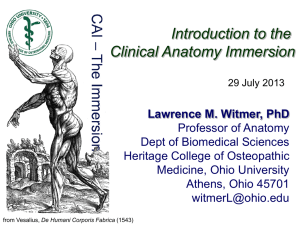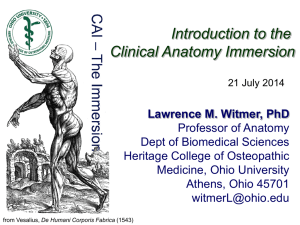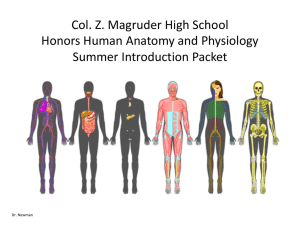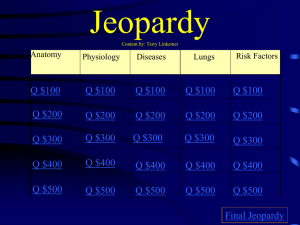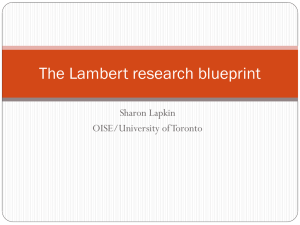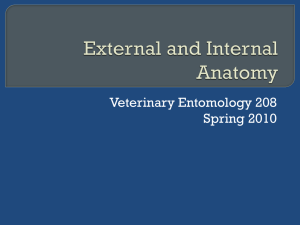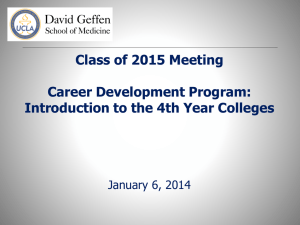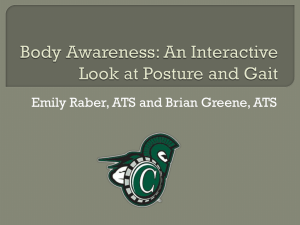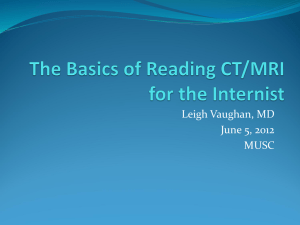The Immersion - Ohio University College of Osteopathic Medicine
advertisement
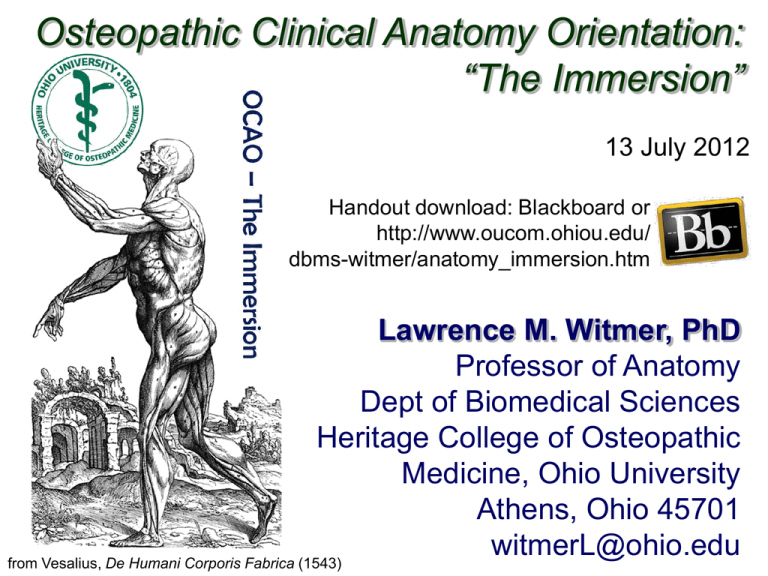
Osteopathic Clinical Anatomy Orientation: “The Immersion” 13 July 2012 Handout download: Blackboard or http://www.oucom.ohiou.edu/ dbms-witmer/anatomy_immersion.htm Lawrence M. Witmer, PhD Professor of Anatomy Dept of Biomedical Sciences Heritage College of Osteopathic Medicine, Ohio University Athens, Ohio 45701 witmerL@ohio.edu from Vesalius, De Humani Corporis Fabrica (1543) Features of the Immersion • Starts early, first medical school experience • “Immersion”—highly focused, few other activities • Four days per week (Mon-Tues-Thurs-Fri) • Three hours of lab per day, balance of time is largely for reading and other preparation • OMM is the other major player in the Immersion • Also, Evidence-Based Medicine…an introduction • Brings all students together prior to PCC & CPC start • Frontloads musculoskeletal anatomy (back & limbs) • Has a strong clinical emphasis Justification for the Immersion • Gross anatomy is the foundation and language of medicine—particularly Osteopathic Manipulative Medicine (OMM) • Provide that foundation prior to beginning the rest of your training • Quickly bring all students up to the same level • Better prepare all our students for OMM training • Provide a clinical focus & orientation at the outset • Starting the process of clinical thinking & problem solving What Is Clinical Anatomy? Systemic Anatomy arterial system Regional Anatomy Clinical Anatomy head & neck Carpal tunnel syndrome • paresthesia • thenar wasting • hand weakness thorax upper limb abdomen & pelvis lower limb (from M&D COA6 2010) median nerve Why Emphasize Clinical Anatomy? • Medical school is for training physicians, not anatomists • Promotes critical thinking and clinical problemsolving using anatomical knowledge • Enhances ability to learn and retain anatomy • Retention is better if learning is done in the context in which it will be ultimately used • “Seeing the forest [clinical application] for the trees [anatomical structures]” • “Reciprocal illumination” • Need anatomy to understand clinical practice • Need clinical correlations to understand anatomy Why Emphasize Clinical Anatomy? A.T. Still’s Four Tenets of Osteopathic Medicine 1. The body is a unit; the person is a unit of mind, body, and spirit 2. The body is capable of self-regulation, selfhealing, and health maintenance 3. Structure and function are reciprocally interrelated 4. Rational treatment is based on the above three principles Anatomy of the Immersion: Webpage Available on Blackboard or http://www.oucom.ohiou.edu/dbms-witmer/anatomy_immersion.htm Anatomy of the Immersion: “Blue Coats” J. Eastman, PhD Professor R. Staron, PhD Assoc. Professor Leah Welsh, Sarah Coffey, MSIV MSIV OMM Fellow DFM Fellow L. Witmer, PhD M. K. Eastman, MS Y. Slyvka, MD J. McCartney, MS Instructor Professor Instructor Instructor Course Coordinator William Porter Grad TA Ashley Morhardt Grad TA Amrita Basu Grad TA Ryan Felice Grad TA Anatomy of the Immersion: Assistants 2nd-Year OU-HCOM medical students • tutoring, prosections, practical exams Kyle Ball, OMSII OU-HCOM TA Michael Halko, OMSII OU-HCOM TA Sarah Hunt, OMSII OU-HCOM TA Rachel Munn, OMSII OU-HCOM TA Sonam Rama, OMSII OU-HCOM TA Anatomy of the Immersion: The Lab • 32 tables, 4 or 5 students/table A B A B A B A B A B A B • Sections A & B, alternate AM/PM slot weekly • Teams do their own dissections. Division of labor: cutters, readers, … B A B A B A B A B A B A • Dissect BOTH sides of cadaver • Come to lab at off times to finish up • Attendance in lab is mandatory Anatomy of the Immersion: The Lab Mandatory Attendance Why? • Material is central to your training • Responsibility to your dissecting team • Honoring the gift of a willed body Stay for the whole lab • Work on dissection • If dissection is completed, work with other resources (e.g., other cadavers, bones, imaging, cross-sections, etc.) Anatomy of the Immersion: The Lab 2010 Renovation Anatomy of the Immersion: Imaging Stations • Plain, CT, MRI • Importance of sectional anatomy for imaging • Very detailed but provide key correlations • Our expectations are modest and reasonable. • PDFs on Blackboard but not for distribution Anatomy of the Immersion: Online http://www.oucom.ohiou.edu/dbms-witmer/3D_human.htm 3D PDFs movies Anatomy of the Immersion: Clinical Themes & Question of the Day A A A A A A A Witmer A A A Clinical Themes • Posted at the beginning of lab • Provide clinical correlations • For your reference; instructors may or may not discuss • Available online prior to lab A A A A Fellow Question of the Day (QOD) • Short clinical vignette • Table team explores the QOD • Witmer & Fellows will discuss QOD with trios or pairs of tables Anatomy of the Immersion: Books • Relevant pages to read are on the schedule. • Moore’s Clinical “Blue Boxes” are key (but you won’t understand them without reading what’s between!) • Dissector & Atlas must be at each table! • Read dissector prior to coming to lab Anatomy of the Immersion: Assessment 1. Required weekly self-assessment quizzes online on Blackboard 2. Required weekly self-assessment lab practical exams 3. Blackboard quizzes & practicals become part of your record although the scores do not dictate P/F in Immersion 4. Formal assessment in the Fall when relevant in PCC (Content Exams) & in CPC (MS Block) 5. The problems presented to you by your patients will continuously test your anatomical knowledge and its clinical application Cadavers & Body Donation • Role of the cadaver: 3D anatomy, variation, “diagnosis” of pathology, etc. • Significance of the cadaver • A profound experience • Directly see & handle structures you’ll later have to imagine • Opportunity and privilege to work on an actual human • Potentially uncomfortable feelings • Death: Illness, end-of-life, dying, corporeal remains • A very different kind of intimacy • Overcoming societal taboos • Sadness: clear evidence of their humanity • Body donation • Conscious, often family decision to donate • The ultimate gift • Honoring that gift • Respect, professionalism • USE the gift: prepare for lab, don’t miss lab, study & learn from all the cadavers • Great book! — Body of Work, by C. Montross, MD
